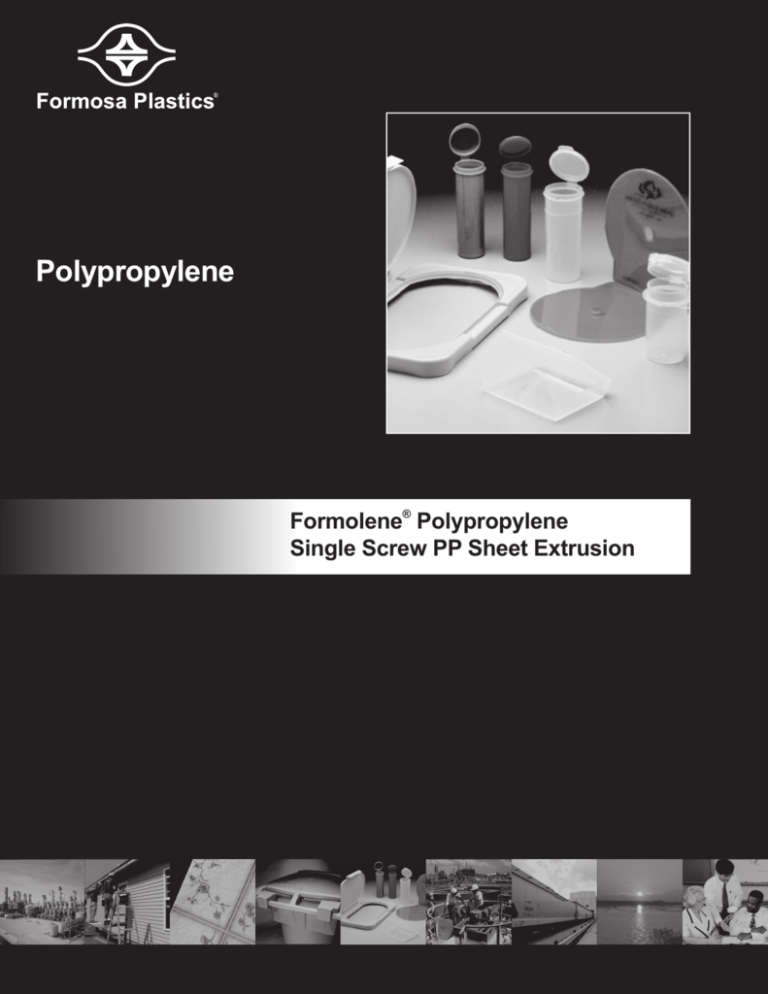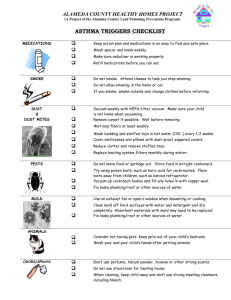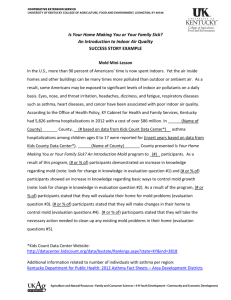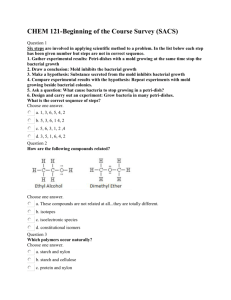Polypropylene - Formosa Plastics Corporation, U.S.A.
advertisement

Polypropylene Formolene® Polypropylene Single Screw PP Sheet Extrusion Processing Guide Single Screw PP Sheet Extrusion Polypropylene is a semi-crystalline polymer that is used extensively due to its unique combination of properties, cost and ease of fabrication. All grades consist of polymer, a neutralizer and antioxidants. Other additives like clarifiers, nucleators, slip additives, UV stabilizers, silica, talc, and calcium carbonate are added to impart specific functionality. The polymer may be a pure homopolymer made by polymerizing propylene, a random copolymer made from propylene and another monomer (like ethylene), or an impact copolymer made by dispersing rubber in polypropylene matrix. Polypropylene can be processed by a variety of fabrication techniques like film/sheet extrusion, multifilament, non-wovens, injection molding, blow molding and profile extrusion. The following guide refers specifically to single screw extrusion; the most commonly used processing step for film and sheet extrusion: L/D ratio = 24:1 to 30:1 Compression ratio = 3:1 to 4:1 Melt Temperature = 200 – 250 °C Pellets Drying – Not essential but helps in insuring consistent feed to extruder Regrind Ratio – 0 to 70% depending upon the end product, quality of regrind and screw configuration. Thickness range (mm) Die gap (mm) Cast Sheet Cast Film (Chill Roll process) Cast Film (Water Bath) Blown Film Ext. Coating 0.25 - 30 0.02 - 6.0 0.07 - 0.25 mm ≤ 0.25 0.005 10% more than desired sheet thickness 0.4 - 0.75 0.4 0.4 < 0.4 230-270 190-230 250-270 Die to chill roll (mm) 40 - 80 at tangent Melt Temperature (ºC) 230-270 Chill Roll Temperature (ºC) 20 Polishing roll temperature (ºC) Temperature variations across chill rolls (ºC) Air knife gap (mm) 230-270 20 (water temp.) 20 >2.9 >3.0 ±1.5 ±1.5 5-10 (water temperature for homopolymer) N.A. 10-30 (water temperature for copolymers) >6-8 -- >3 Approximately 1.5 Common Sheet Extrusion Problems and Possible Corrective Action Problem Observed Possible Causes Corrective Actions Thickness variation in machine direction (Surging) 1. Inconsistent raw material feed • Insure consistent bulk density of feed 2. Varying hopper level • Adjust hopper level control 3. Feed section too hot • Increase feed throat cooling 4. Raw material temperature too cold • Condition raw material to room temperature 5. Melt pressure too low • Increase head pressure 6. Screw speed variation >1% • Adjust motor control 1. Uneven melt temperature • Increase mixing by head pressure 2. Low melt temperature • Increase extruder temperatures Thermal degradation of resin, additives or regrind Check melting point of all components to compare with melt temperature Dull streaks or low gloss 2 Dark specks, dark streaks, discoloration Processing Guide Single Screw PP Sheet Extrusion Common Sheet Extrusion Problems and Possible Corrective Action (continued) Problem Observed Possible Causes Corrective Actions Gels 1. Contamination in raw materials or regrind • Clean out hopper and feed lines before switching raw material lots 2. Unmelted plastics • Increase temperature 3. Degraded polymer • Decrease temperature 1. Moisture in the feed • Use dry raw materials 2. Trapped air in the feed • Increase head pressure • Increase temperature in feed zone. • Ensure that the feed consist of uniform particle sizes Uneven coloring Poor mixing • Increase head pressure • Decrease line speed Scuffs and scratches Mismatch in line speed and roller speed Check for stuck or slow rollers Orange peel Localized uneven shrinkage May be related to moisture, air Shark skin Material viscosity too high Increase melt temperature Lines across the web (transverse direction) Chatter in the roll stack drive train • Drive chain tension too loose • Drive chain may be too long • Drive chain may be worn out Flow lines Large plastic bank at nip roll Control output to insure constant bank Die lines Nicks, scratches or particles in the die or on the lips Examine surface to establish the exact source Holes or bubbles Thermoforming All thermoforming processes are preceded by sheet extrusion described above. The sheet may be cut in specific length or wound on cores for offline forming or fed directly to the thermoformer (inline operation). The inline operation may utilize rotary machine for hot forming or may consist of roll stack for first cooling the sheet, reheating and then feeding to the thermoformer. In addition to the type of material being input, other options in thermoforming include: • Forming force (vacuum, positive air pressure, power press) • Mold type (female, male, matched male/female) • Sheet pre-stretch (vacuum, positive air pressure/ billow, mechanical plug), • Heating means (Radiation-rod, ceramic, quartz, IR; Convection – hot air oven, Conduction – hot roller, contact panel, hot oil bath). Equipment suppliers are the best source to advise on the selection of these options for specific applications. The lightweight, high softening point, ability to hot fill and microwave make polypropylene suitable for deli containers, disposable cold drink cups, ready meat trays and blister packs for medical and pharmaceutical packaging. There are two distinctive ways to thermoform polypropylene. When forming is carried out below crystalline melting point, it is known as solid phase forming. Melt phase forming is performed at temperatures above the crystalline melting point. Solid phase forming is carried out at temperatures ranging from 155ºC to 165ºC. Under these conditions, the sheet is relatively strong and resistant to sagging and usually requires plug assist to pre-stretch the sheet. A small change in temperature results in large change in forming force. This technique can be used to process all thermoforming grades of polypropylene. Melt phase forming is performed at temperatures ranging from 170ºC to 180ºC and requires polypropylene grades with a high melt strength. Parts formed with Melt phase forming are more even, have lower residual stress and greater heat resistance. On the other hand, parts formed with Solid phase forming are clearer and stronger. 3 Processing Guide Single Screw PP Sheet Extrusion Common Thermoforming Problems and Possible Corrective Action 4 Problems Observed Possible Causes Corrective Actions A. Incomplete Forming, Poor Detail 1. Sheet too cold • Heat sheet longer (reduce line speed) • Raise temperature of heaters • Use more heaters • If problem occurs repeatedly in same area, check for lack of uniformity of heat 2. Clamping frame not hot before inserting sheet • Preheat clamping frame before inserting sheet 3. Insufficient vacuum and/or compressed air • • • • 4. Vacuum not drawn fast enough • Use vacuum slots instead of holes where possible • Add vacuum surge and/or pump capacity • Enlarge vacuum line and valves avoiding sharp bends at tee and elbow connections • Check for vacuum leaks • Back-relieve the vacuum holes • Check vacuum system for minimum 25” of Hg pressure 5. Additional pressure needed • Use 20-50 psi air pressure on part opposite mold surface if mold will withstand this pressure • Use frame assist • Use plug silicone slab rubber, or other pressure assist B. Sheet Scorched 1. Outer surface of sheet too hot • Shorten heat cycle • Use slower, soaking heat (lower temperature) • Move heater bands further from sheet C. Blushing or Change in Color Intensity 1. Insufficient heating • Lengthen heat cycle • Raise temperature of heaters 2. Excess heating • Reduce heater temperature • If in same spot on sheet, check heaters • Shorten heater cycle 3. Mold too cold or hot • Heat mold or lower temperature 4. Assist is too cold • Warm assist or use syntactic foam or felt-covered plug 5. Sheet being stretched too far • Use heavier gauge sheet or- more elastic, deep draw formulation 6. Sheet cools before it is completely formed • Move mold into sheet faster • Increase rate of vacuum withdrawal • Be sure molds and plugs are hot 7. Uncontrolled use of regrind • Control percentage and quality of regrind D. Whitening of Sheet 1. Cold sheet stretching beyond its temperature yield point • Increase heat of sheet; increase speed of drape and vacuum E. Webbing, Bridging or Wrinkling 1. Sheet too hot causing too much material in forming area • Shorten heating cycle • Increase heater distance • Lower heater temperature 2. Melt strength of resin too low (sheet sag too great) • Change to lower melt index resin, if possible • Use minimum sheet temperature possible • Profile temperature of sheet 3. Too much or too little sheet orientation • Have sheet supplier reduce or increase orientation 4. Insufficient vacuum • Check vacuum system 5. Extrusion direction of sheet parallel to space between molds • Move sheet 90 degrees in relation to space between molds. Orient molds Check vacuum holes for clogging Check for vacuum or air leak Increase number and size of vacuum holes Remove any 90 degree angles in vacuum system Processing Guide Single Screw PP Sheet Extrusion Common Thermoforming Problems and Possible Corrective Action Problems Observed Possible Causes F. Nipples on Mold Side of Formed Part 1. Sheet too hot • Reduce heating cycle • Reduce heater temperature • Reduce temperature of sheet surface that contacts mold 2. Vacuum holes too large • Plug holes and re-drill with smaller bit • Use slot vacuum 1. Sheet too hot • Reduce heating cycle • Reduce heater temperature 2. Melt flow rate too high • Use thinner gage sheet 3. Sheet area too large • Profile heat the sheet; use screening or other means of shading or giving preferential heat to sheet, thus reducing relative temperature of center of sheet 1. Variation in sheet temperature • Check for air drafts through oven using solid screens around heater section to eliminate 2. Wide sheet gage variation • Adjust sheet thickness profile 3. Sheet made from different resins; not a homogeneous mixture • Control regrind percentage and quality • Avoid resin mix-ups 1. Plug assist temperature too low • Increase plug assist temperature • Use syntactic foam plug assist • Cover plug with cotton flannel or felt 2. Mold temperature too low – stretching stops when sheet meets cold mold (or plug) • Increase mold temperature not exceeding “set temperature” for particular resin • Relieve molds in critical areas 3. Inadequate mold temperature control • Add additional cooling lines/tubes to tools • Check for plugged water flow 4. Sheet too hot • Reduce heat • Heat more slowly • Lower surface temperature of sheet • Slightly chill surface of hot sheet contacting mold with forced air before forming 1. Pock marks due to air entrapment over smooth mold surface • Grit blast mold surface 2. Poor vacuum • Add vacuum holes • Check entire vacuum system • If pock marks are in isolated area, add vacuum holes to this area or check for plugged vacuum holes or vacuum leak. G. Too much sag H. Sag Variation Between Sheet Blanks I. Chill Marks or “Mark Off” Lines J. Bad Surface Markings 3. Mark-off due to accumulation of plasticizer on mold when using sheet with plasticizers • Use temperature controlled mold • Have mold as far away from sheet as possible during heating cycle • If too long, shorten heating cycle • Wipe mold 4. Mold is too hot • Reduce heat • Heat more slowly • Lower surface temperature of sheet • Slightly chill surface of hot sheet contacting mold with forced air before forming 5. Mold is too cold • Reduce mold temperature 6. Improper mold composition • Avoid phenolic or other “heat sink” glossy molds with clear transparent sheet • Use aluminum molds where possible 7. Mold surface too tough • Smooth surface • Change mold material • Sand blast mold surface with #30 shot grit 5 Processing Guide Single Screw PP Sheet Extrusion Common Thermoforming Problems and Possible Corrective Action Problems Observed Possible Causes Corrective Actions J. Bad Surface Markings (Continued) 8. Dirt on sheet • Clean sheet • Use ionized air blow 9. Dirt on mold • Clean mold 10. Dust in atmosphere • Clean thermoforming area; isolate area if necessary and supply filtered air • Use ionized air 11. Contaminated sheet materials • If regrind is used be sure to keep clean and different materials stored separately 12. Scratched sheet • Separate sheets with paper in storage • Check for ext. die scratches • Check ext. roll polish 1. Sheet overheated in this area • • • • 2. Bad sheet • Check with sheet supplier 1. Removed part from mold too soon • Increase cooling cycle • Use cooling fixtures • Use fan or vapor spray mist to cool part faster on mold 2. Too much sheet orientation or non-uniform orientation • Optimize extruder/die conditions • Reduce die draw ratio 1. Uneven part cooling • Add more water channels or tubing to mold • Check for plugged water flow • Cool part at same rate on both sides 2. Poor wall distribution • • • • 3. Mold temperature too low • Raise mold temperature to just below “set-temperature” of sheet material 4. Too much or non-uniform orientation in sheet • Check extruder/die conditions 1. Improper sheet sag • Consider changing direction of extrusion of sheet. • Try more orientation in sheet • Check percentage of regrind. 2. Variations in sheet gauge • Adjust extruder/die conditions 3. Hot or cold spots in sheet • Improve heating technique to achieve uniform heat distribution; screen or shade as necessary • Check to see if all heating elements are functioning 4. Stray drafts and air currents around machine • Enclose heating and forming areas 5. Too much sag • Use screening or other temperature control of center areas of heater banks • Use more orientation in sheet 6. Mold too cold • Provide uniform heating of mold to bring to proper temperature • Check temperature control system for scale or other stoppage 7. Sheet slipping out of frame • Adjust clamping frame to provide uniform pressure • Check for variation in sheet gauge • Heat frames to proper temperature before inserting sheet • Check for non-uniformity of heat giving cold areas around clamp frame K. Shiny Streaks on Part L. Excessive shrinkage or distortion of part after removing from mold M. Part Warpage N. Poor wall thickness distribution and excessive thinning or holes in some areas when sheet stretched 6 Lower heater temperature in scorched area Shield heater with screen wire to reduce overheating Slow heating cycle Increase heater to sheet distance Improve pre-stretching or plugging techniques Use plug assist Check for non-uniformity of sheet heating Check sheet gauge Processing Guide Single Screw PP Sheet Extrusion Common Thermoforming Problems and Possible Corrective Action Problems Observed Possible Causes Corrective Actions O. Non-uniform prestretch bubble 1. Uneven heating of sheet • • • • 2. Stray air drafts • Enclose or other wise shield or screen machine • Check clamping frame air cylinders for leaks 3. Non-uniform air blow • Baffle air inlet in pre-stretch box 1. Inadequate vacuum • Check for vacuum leaks • Add vacuum surge and/or pump capacity • Check for plugged vacuum holes • Add vacuum holes 2. Mold surface too smooth • Grit blast mold surface with #30 grit 3. Part shrinking away • May be impossible to eliminate on thick sheet with vacuum only; use 20-30 psi air pressure on part opposite mold surface if mold will withstand this pressure • Add mote to mold just outside trim line 1. Sheet too thin • Use heavier gauge 2. Variation in sheet temperature • Profile sheet heating: adjust heating as needed by adding screens to portion of sheet going into corners or with panel heat lower temperature • Cross hatch sheet with markings prior to forming so movement of material can be accurately checked 3. Variation in mold temperature • Adjust temperature control system for uniformity 1. Mold or sheet temperature too high • Increase cooling cycle • Slightly lower mold temperature, not much less than recommended by resin manufacturer • Lower surface temperature on sheet side that contacts mold 2. Not enough draft in mold • Remove part from mold as early as possible; if above “set temperature”, use cooling jigs 3. Mold undercuts • Use stripping frame • Increase air-eject air pressure • Remove part from mold as early as possible; if above “set temperature”, use cooling jigs • Change mold design for undercut to break away 4. Rough mold surface • Polish corners or all of mold • Use mold release • Use Teflon spray or Zinc Stearate S. Sheet sticking to plug assist 1. Improper metal plug assist temperature • Reduce plug temperature • Use mold release • Teflon coat plug • Cover plug with felt cloth or cotton flannel • Use syntactic foam plug T. Tearing of sheet when forming 1. Sheet too hot • Use heavier gauge 2. Sheet too cold (usually thinner gauges) • Profile sheet heating: adjust heating as needed by adding screens to portion of sheet going into corners or with panel heat lower temperature • Cross hatch sheet with markings prior to forming so movement of material can be accurately checked 3. Closing speed between mold and sheet • Adjust temperature control system for uniformity P. Shrink marks on part, especially in corner areas (inside radius of molds) Q. Corners too thin in deep draws R. Part sticking to mold Extruder/die to obtain uniform sheet Check heater section for heaters out Check heater section for missing screens Screen heater section as necessary 7 9 Peach Tree Hill Road, Livingston, NJ 07039 • www.fpcusa.com ©2006 Formosa Plastics Corporation, U.S.A. Revised: June 2006





